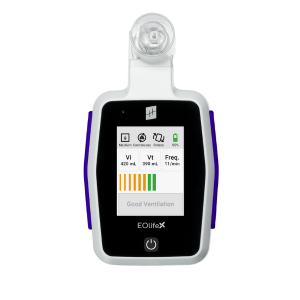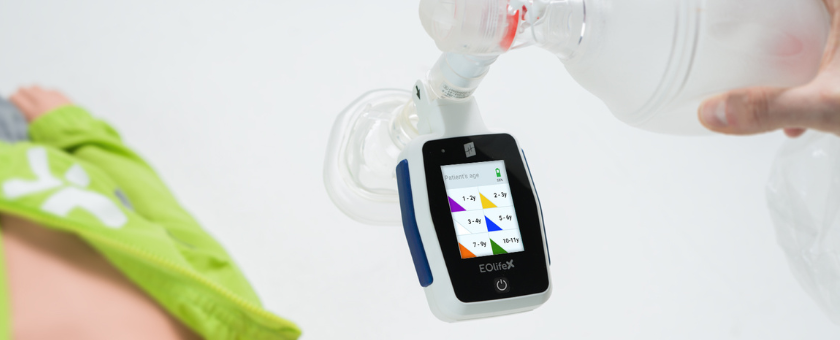Pediatric ventilation during cardiac arrest is a major concern among EMS teams. Given the unique physiology of children, the recommended tidal volumes are far smaller than for adults, while the required ventilation rates are considerably higher. The diversity of tidal volumes and rates according to age makes this maneuver even more complex. Blindly estimating the appropriate volume for a given child – without a ventilation feedback device – is extremely difficult. These factors combined make pediatric ventilation one of the most challenging skills to perform effectively in prehospital care.
A new study puts pediatric manual ventilation skills to the test
In a simulation study published in September 2025 [1], J.D. Finney et al. investigated the quality of manual ventilation performed by EMS clinicians across the Saint Louis metropolitan area in a simulated prehospital pediatric ventilation scenario, both with and without the support of a training ventilation feedback device (EOlife X). The study included Emergency Medical Technicians (EMTs) and paramedics who were enrolled during their shifts.
A realistic single-blinded, randomized crossover simulation trial
The study was designed as a single-blinded, randomized crossover trial. Seventy-four participants were randomly allocated to one of two groups. Each group completed two simulated pediatric respiratory arrest scenarios, utilizing a high-fidelity toddler manikin representative of a 3-year-old patient. The scenario simulated an apneic, post-ictal child following a febrile seizure. When surveyed, most participants believed the scenario was realistic (97.3%).
In the first scenario, Group 1 participants received real-time feedback from EOlife X, while Group 2 was blinded to feedback by using the device in blind mode. After a 10-minute washout period—during which participants were free from study activities but required not to discuss any aspect of the trial—the groups crossed over and repeated the scenario. Each scenario consisted of two uninterrupted minutes of manual ventilation.
Ventilation quality was measured using the EOlife X training ventilation feedback device, which recorded tidal volume, ventilation rate, and leakage ratio.

EOlife X, the ultimate tool for high-performance ventilation training.
Training tool allowing calculation and recording of insufflated volume, tidal volume, manual ventilation frequency, in real time, to practice ventilation in accordance with ERC and AHA recommandations. EOlife X enables training on adult and pediatric (>1 year) manikins.
Main outcomes
- Proportion of ventilations delivered within the target tidal volume of 6–8 mL/kg (84–112 mL for the simulated patient).
- Proportion of ventilations delivered at the correct frequency, calculated based on 25 breaths (one breath every 2–3 seconds).
- Proportion of ventilations with inspiratory and expiratory volumes differing by less than 30% to assess mask seal quality.
Key findings: a drastic improvement in ventilation quality with EOlifeX
The results clearly demonstrated the impact of EOlife X feedback:
- Adherence to tidal volume guidelines was significantly higher in unblinded participants (median 73.3%) compared to blinded participants (median 13.5%).
- Adherence to ventilation rate guidelines improved substantially with EOlife X feedback (median 96%) versus blinded participants (median 57.5%).
- Leakage ratio was reduced from 21.2% without feedback to 10% with feedback.
- Finally, when surveyed, most participants (98.6%) reported that EOlife X would help them ventilate pediatric patients more appropriately in real-life clinical practice.
EOlife X, bridging the gap: from training guidelines to real-world confidence
This study highlights the considerable difficulty EMS clinicians face when performing pediatric ventilation without feedback. But most importantly, it shows the dramatic improvement in performance when guided by EOlife X in a simulated environment. The device significantly increased adherence to tidal volume and ventilation rate targets while reducing leakage; demonstrating its clear potential to improve ventilation quality.
Importantly, the findings underscore both the urgent need for feedback devices in pediatric ventilation and how strongly EMS teams trust that such devices would help them ventilate more effectively in real clinical practice.
Children are particularly vulnerable to both hypo- and hyperventilation, and ensuring accurate delivery of ventilation is critical. EOlife X provides EMS professionals with real-time feedback to enhance training sessions, helping bridge the gap between theoretical guidelines and practical skills. By supporting both competence and confidence, it represents an indispensable component of pediatric ventilation training and education and should be adopted widely to better prepare EMS teams for real-life pediatric emergencies.

To learn more about how EOlife X can enhance your training protocols,
Request a demo today
References
(1) Joseph D. Finney, Jeffrey Siegler, Jinli Wang, Elizabeth Larkin, Kavya John, Brad McClain, Sang Hoon Lee, Lauren C. Riney, Lynn Babcock, Lorin R Browne & Fahd A. Ahmad (11 Sep 2025): Feasibility and Preliminary Outcomes of a Simulated Prehospital Pediatric Ventilation scenario Using a Ventilation Feedback Device, Prehospital Emergency Care, DOI: 10.1080/10903127.2025.2558861


